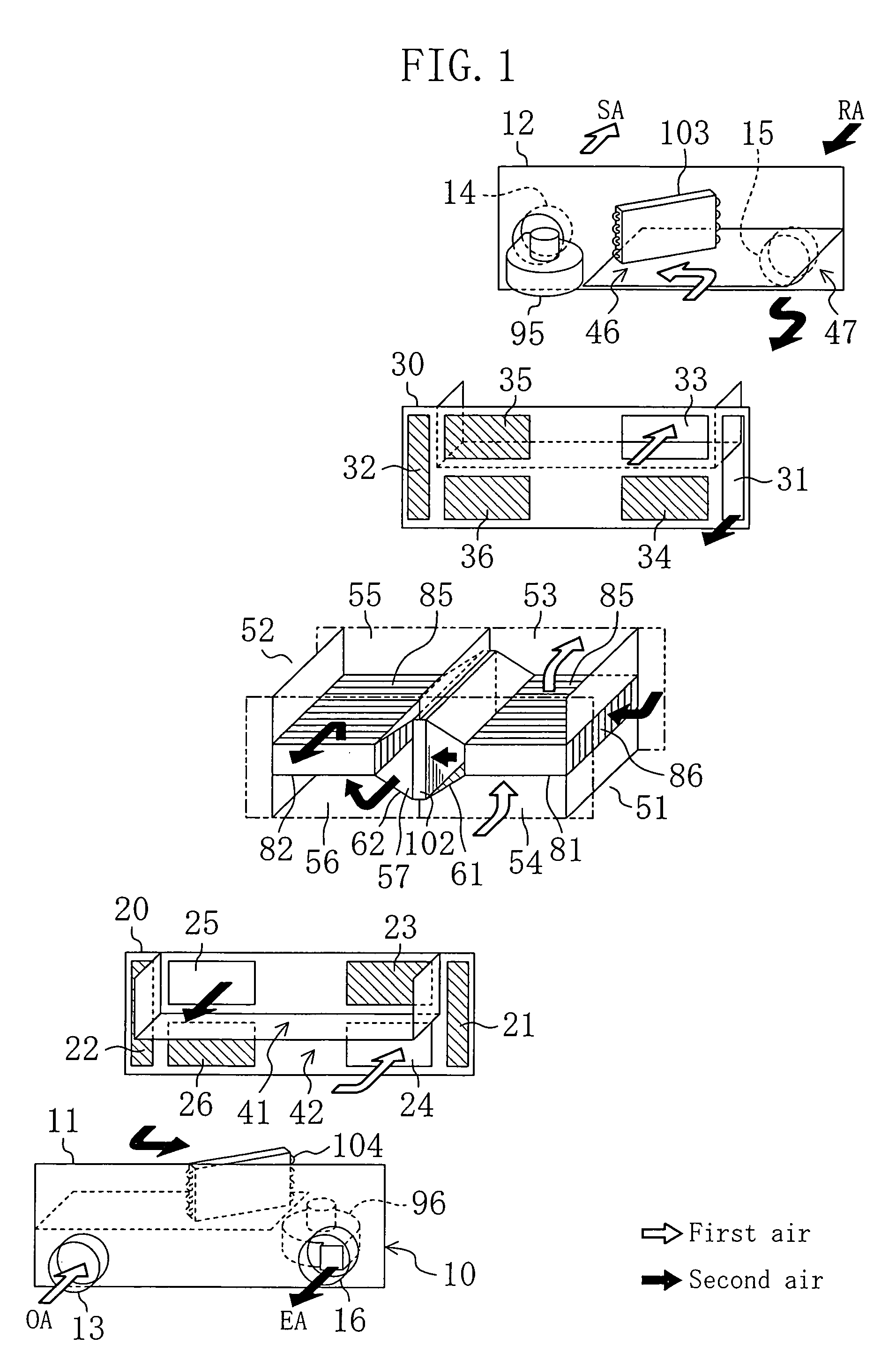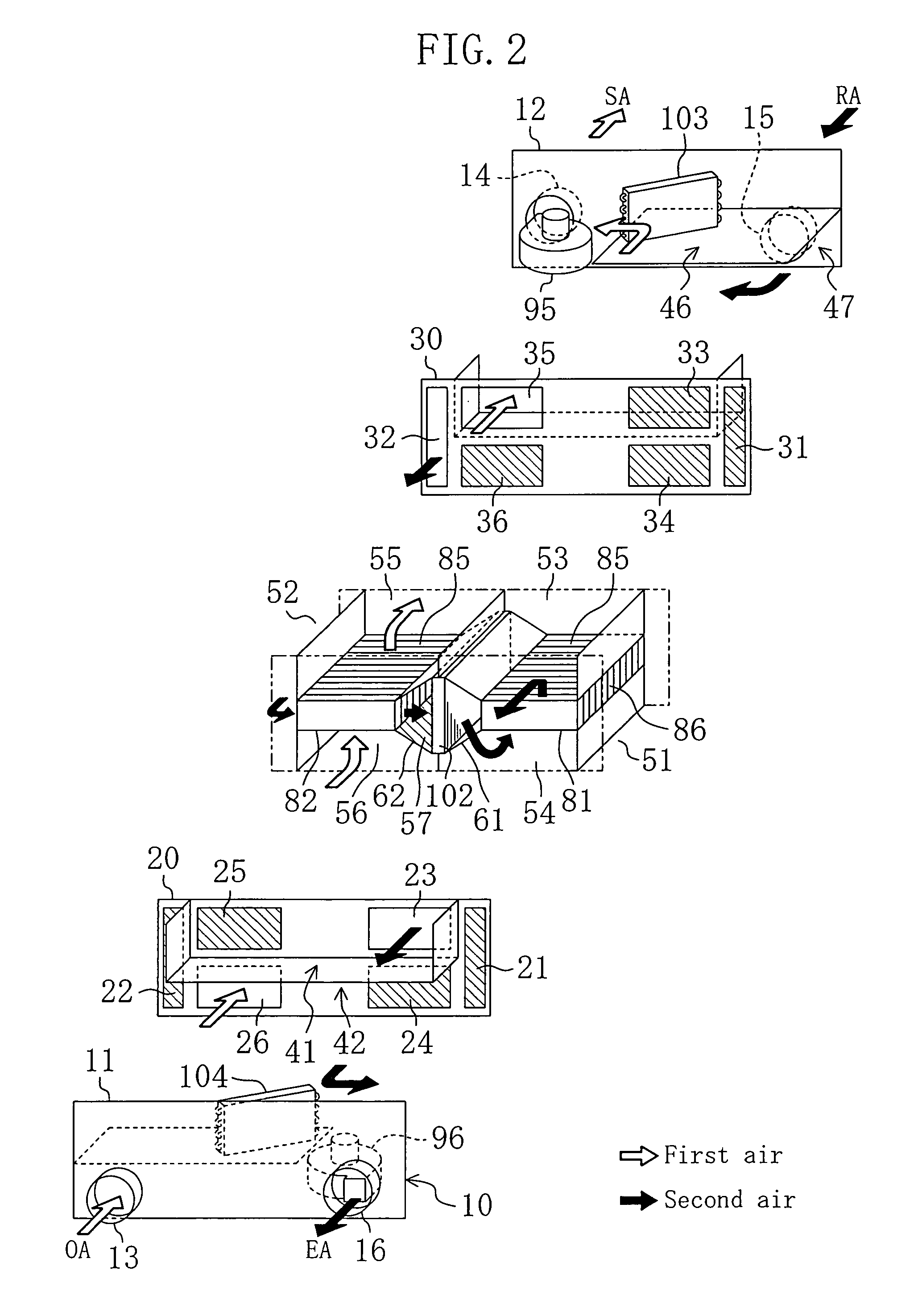Humidity control apparatus
a technology of humidity control and humidification apparatus, which is applied in the direction of lighting and heating apparatus, domestic cooling apparatus, heating types, etc., can solve the problems of reducing the moisture content of the supply air, failing to provide a sufficient humidification capacity, and insufficient capacity, so as to improve the humidification capacity and efficiency of use. , the effect of efficient us
- Summary
- Abstract
- Description
- Claims
- Application Information
AI Technical Summary
Benefits of technology
Problems solved by technology
Method used
Image
Examples
embodiment 1
[0110]A humidity control apparatus according to the present embodiment is switched between the dehumidification mode in which a dehumidified air is supplied into the room and the humidification mode in which a humidified air is supplied into the room. Moreover, the humidity control apparatus includes a refrigerant circuit (100) and two adsorbing elements (81, 82), and performs a so-called “batch” operation. The configuration of the humidity control apparatus according to the present embodiment will now be described with reference to FIG. 1, FIG. 5, FIG. 6 and FIG. 7.
[0111]General Configuration of Humidity Control Apparatus
[0112]As illustrated in FIG. 1 and FIG. 5, the humidity control apparatus includes a casing (10) having a somewhat flattened, rectangular parallelepiped shape. The casing (10) accommodates the two adsorbing elements (81, 82) and the refrigerant circuit (100). The refrigerant circuit (100) includes a regenerative heat exchanger (102), a first heat exchanger (103) an...
embodiment 2
Effects of Embodiment 2
[0238]According to the present embodiment, the following effects are realized in addition to those obtained in Embodiment 1.
[0239]Specifically, with the humidity control apparatus of the present embodiment, in the dehumidification mode, heat collected from the second air to be discharged can be reused for heating the second air in the regenerative heat exchanger (102). Therefore, with the humidity control apparatus, the internal energy of the second air to be discharged can be efficiently used for the operation of the humidity control apparatus.
[0240]Moreover, with the humidity control apparatus of the present embodiment, in the humidification mode, heat collected from the first air to be discharged can be used for heating the first air in the regenerative heat exchanger (102). Therefore, with the humidity control apparatus, the internal energy of the first air to be discharged can be efficiently used for the operation of the humidity control apparatus.
[0241]M...
embodiment 3
Effects of Embodiment 3
[0282]According to the present embodiment, the following effects are realized in addition to those obtained in Embodiments 1 and 2.
[0283]Specifically, with the humidity control apparatus of the present embodiment, in the third operating mode of the humidification mode, the second air can be humidified and then further heated before it is supplied into the room. Therefore, the humidity control apparatus can not only control the humidity of, but also heat, the air in the room. Moreover, in the refrigerant circuit (100) in this mode, the regenerative heat exchanger (102) and the first heat exchanger (103), which both serve as a condenser, are parallel to each other. Therefore, as compared with a case where the regenerative heat exchanger (102) and the first heat exchanger (103) both serving as a condenser are in series with each other, the amount of heat to be given from the refrigerant to the second air through the first heat exchanger (103) can be increased, th...
PUM
 Login to View More
Login to View More Abstract
Description
Claims
Application Information
 Login to View More
Login to View More - R&D
- Intellectual Property
- Life Sciences
- Materials
- Tech Scout
- Unparalleled Data Quality
- Higher Quality Content
- 60% Fewer Hallucinations
Browse by: Latest US Patents, China's latest patents, Technical Efficacy Thesaurus, Application Domain, Technology Topic, Popular Technical Reports.
© 2025 PatSnap. All rights reserved.Legal|Privacy policy|Modern Slavery Act Transparency Statement|Sitemap|About US| Contact US: help@patsnap.com



